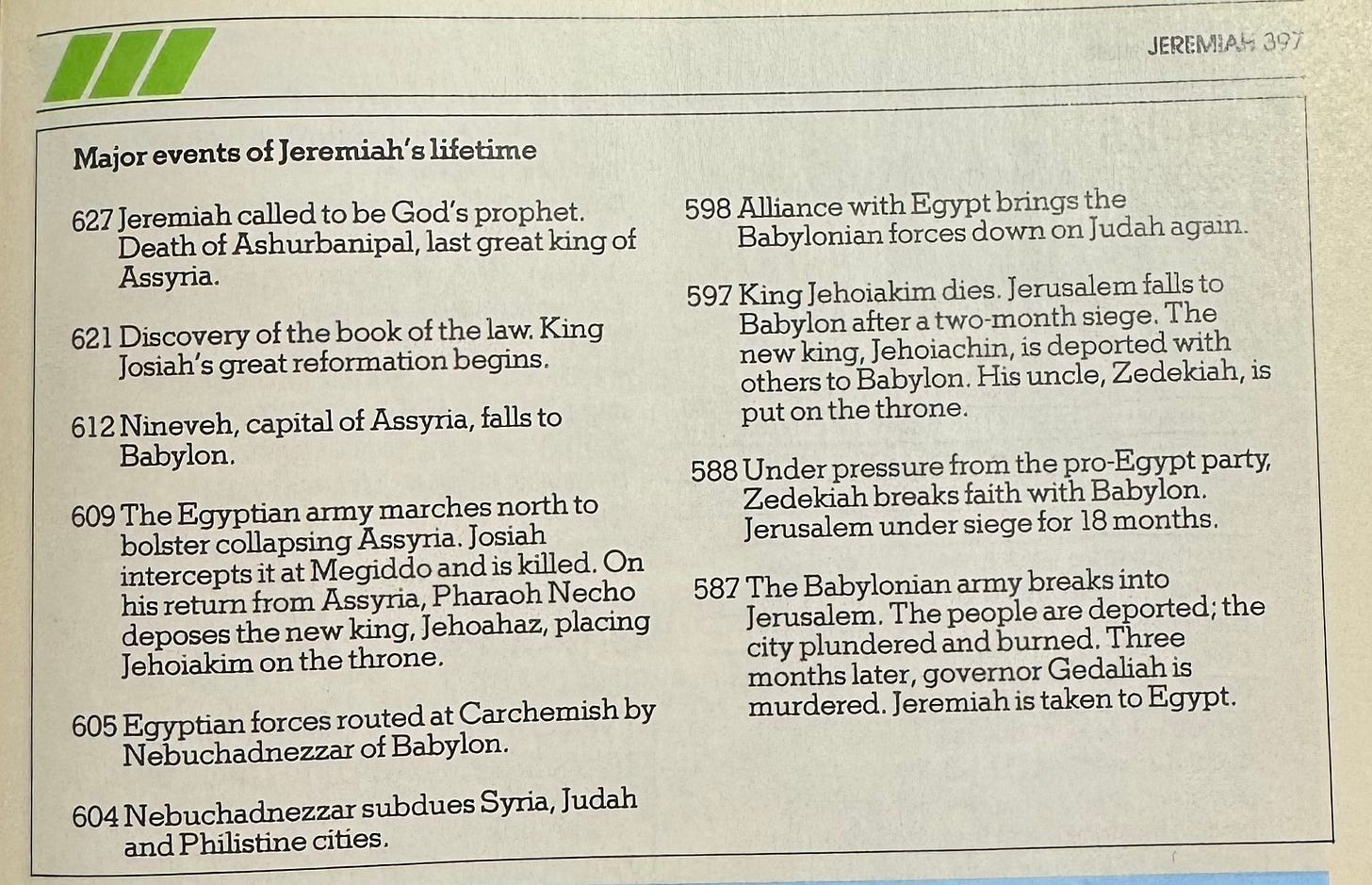A Bit About Jeremiah
An overview of the Old Testament book introducing the new series of my Route 66 podcast
A Bit About Jeremiah
Pastor Mark Daniels
July 3, 2024
Jeremiah was a somewhat older contemporary of the Old Testament prophet, Ezekiel, and the Old Testament apocalypticist, Daniel. Unlike, Ezekiel and Daniel though, Jeremiah remained in Judah and, for the sake of speaking God’s truth to God’s people, he would go to Egypt, where many had been cast.
Jeremiah lived about 100 years after the prophet Isaiah.
Jeremiah was called to be a prophet in 628 BC and gave his last prophecy in 580 BC. The ministry of “prophet’ brought Jeremiah incredible suffering. His persistence in following the God we now know in Jesus and in fulfilling the hard ministry God gave him is remarkable.
The Lutheran Study Bible gives these Law themes in the book of Jeremiah: “The nations plucked up, broken down, destroyed, and overthrown; punishment of Judah [God’s people] by sword, famine, and pestilence; faithless shepherds;...[Judah as a land] forsaking the Lord and His covenant, [guilty of] idolatry; Judah cursed like Sodom.” (Let that last point sink in. Check out: Genesis 18:16-21, 32-33; 19:23-29)
The Lutheran Study Bible identifies these Gospel themes in the book of Jeremiah: “The nations built and planted; the Lord will [turn from His anger with Judah]; the remnant [the exiled remains of Judah] will return; a righteous branch [will] sit on David’s throne*; new covenant, new hearts; God’s steadfast love and mercy; judgment of the nations [those who reject God’s lordship and His people and witnesses].”
*[Here we see an example of what I call “prophetic telescoping.” A prophet’s oracles usually contain prophecies both about God’s immediate activity AND about God’s future activity. Here, we see that God gives Jeremiah information about both the vindication of the faithful remnant of Judah AND the Messiah Who will bring God’s life and forgiveness definitively into the cosmos.]
Eerdmans Handbook to the Bible
summarizes the major events of Jeremiah’s life in this chart.
[Apologies for the crooked image.]
The illustration below also comes from the Eerdmans handbook. It shows the last kings of Judah, in other words, the last kings to reign over what was left of Israel. The modern state of Israel, established in 1947, should not be confused with ancient Israel, although people in the modern nation might share a genetic connection to the descendants of Abraham, Isaac, and Jacob and though many may recognize the authority of what we call the Old Testament. As the apostle Paul, a Jewish-Christian, writes, particularly in Romans 9-10, being a descendant of Abraham really is about having the same faith in God that Genesis tells us Abraham had. (“Abraham believed and God reckoned it as righteousness.”) Hence, the little formula: Ancient Israel is the Old Testament Church; the Church is the New Testament Israel.
So, ancient Israel is the Old Testament Church anticipating the ultimate vindication of faith in Jesus; the Church established by Jesus is the New Testament Israel proclaiming the crucified, risen, living, and one-day-returning Jesus as God in the flesh and the fulfillment of God’s promises of a Savior.
Also from the Eerdmans handbook: “Jeremiah’s book…is a glorious mixture of literary forms: prose and poetry, taunt and lament, acted parable, biography and history. He added bits to it at various times, and not all of them are dated. The material is not arranged in historical order, which makes some of it difficult to set against the right background.”
The Lutheran Study Bible does a good job of describing the purpose of Jeremiah’s book: “To call Judah to repentance, announce the Babylonian exile, and prophesy the new covenant.”





